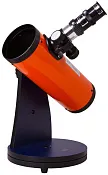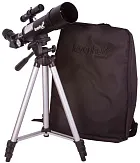Telescopes for children
Children are curious and want to know everything, and their effort to acquire knowledge about the world around us is sometimes admirable. Eventually, they notice that the Sun rises and sets, and the Moon phases change. They hear about the "zodiac signs" or watch the Star Wars movies. One way or another, all kids become interested in astronomy. It is often up to the parents whether their kids can realize that the world extends beyond the Earth, the Solar system or even our Galaxy; that the Universe is enormous!
You can choose and acquire the best kid’s telescopes on our website!
Does your kid need a telescope?
Remember your childhood: you probably read science fiction books on astronomy or fantasy books on space journeys, or at least "Andromeda Nebula", a famous novel by Ivan Yefremov. However, the lucky few had a chance to perform equipped observations of the skies. Moreover, optical instruments have become more affordable these days and almost all parents can acquire a kid’s telescope. Here may come the question: is it necessary? It is your choice, but if a child is keen on astronomy, he or she will be happy to receive a real telescope as a gift. It is better to see once with your own eyes than hear a hundred times, read, watch or look through the pictures and photos. Besides, such a gift can lead a child to become interested in science subjects, especially physics and maths, which is great for academic progress.
At what age is it better to start observations?
What should a kid’s telescope look like? It depends a lot on the age of the kid. The youngest explorers cannot observe without help because they get bored fast without parents around, not to mention the danger of leaving kids alone at night these days. A kid of eight to ten years of age can cope with a small telescope and observe, for example, on a balcony or in the backyard of a house. So, we can proceed from there.
Levenhuk LabZZ series –
telescopes for the youngest astronomers
What you can observe through a small telescope?
Newbies of all ages are usually interested in observing the bright and not distant objects. The Moon, the Sun (observe with a special filter only!), and binary stars. These objects can be clearly observed through any optical device, and even a small telescope allows observing a lot. Of course, you cannot see an American flag on the surface of the Moon, but you can gaze upon the vastness of space, watch the surface of a satellite, the lunar seas and mountains. It is not necessary to acquire an expensive telescope for kids; even a simple instrument will enchant a kid as soon as he or she sees the lunar crater, the rings of Saturn, the moons of Jupiter or the distant Andromeda Galaxy.
Telescope series for kids
As a rule, all leading manufacturers of astronomy equipment produce a special telescope series for kids; for example, Levenhuk LabZZ or Levenhuk Strike NG series. Usually they are small (of 80–90 mm diameter) achromatic refractors on altazimuth mounts. Refractor telescopes are durable, reliable, low-maintenance tools that do not need adjustment and transmit a "terrestrial" upright image. The objective diameter is sufficient for an introduction to the starry sky. It is also important that a kid quickly realize that he or she sees a telescope: the refractor’s optical scheme is classic, a "gold standard" or a "telescope symbol". If you ask a person who has nothing to do with astronomy to draw a telescope, they will draw the refractor. Besides, it will perfectly match the interior of any apartment.
Apart from the refractors, kids will also love small Newtonian reflectors on the desktop Dobsonian mounts, for example, Levenhuk LabZZ D1 or Levenhuk Skyline 76x700 AZ Telescope. Kids will love the bright design of the models, and parents will appreciate their compact size.
Convenient use
Altazimuth mount is lightweight and perfect for both astronomy and terrestrial observations and does not require polar axis adjustment as this installation, easy for an adult, can be too difficult for a kid. Of course, to perform astronomy observations, you should know the celestial coordinates, yet the convenience of the equatorial mount does not compensate for the difficulties that an inexperienced observer will probably face. You should turn to the mounts with slow motion controls because they make observations more convenient - there is an opportunity to compensate smoothly for the daily rotation of the celestial sphere by putting the micrometer screws on. It is especially valuable at high magnifications. A telescope of this type is easily disassembled; it will not be heavy and bulky. Even the large tools weigh only 7 kilos, and you may even take public transport to carry the instrument.
Levenhuk Skyline Travel 50 Telescope is a perfect choice for observations away from city lights, as well as hiking trips and weekends away with all the family members. The tube is compact and lightweight – it is half the size of most refractor tubes. Due to the lightweight design, now even a kid can travel with a telescope.
Basic accessories for telescopes
If you decide to acquire a kid’s telescope, you should pay attention to the standard equipment: no one likes to unwrap a tool and discover that it is unsuitable for use right away, "out of the box" – it will detract from the excitement of the gift. The kit should contain everything necessary for observations, and it will be great if the standard equipment includes some reference sources: a planisphere, a set of posters, educational literature, a planetarium and additional accessories. Of course, a telescope for kids should be wrapped in a beautiful gift box because the first impression means a lot, and it is very important to create a good impression when introducing a child to this instrument. The leaders among the telescopes with the rich kits are Levenhuk Strike NG series instruments. These telescopes are equipped with advanced kits: you receive the optical accessories for performing astronomy and terrestrial observations, and many reference and text books for the first acquaintance with astronomy and its further detailed studies.
All refractor telescopes with a diagonal mirror transmit an undistorted but mirrored image. Besides, many telescopes come with kits that include an erecting eyepiece or a diagonal prism to receive a standard upright (not mirrored) image, which is helpful for observations of terrestrial objects. It is interesting to observe terrestrial landscapes, animals and birds, as entertaining as studying celestial objects, especially if the sky is overcast for too long. If astronomy will not become a serious hobby, you can always use a telescope as a spotting scope.
Is it possible to take pictures through a telescope?
Before acquiring a telescope for a kid, people often wonder if they can take pictures with it. The older models in the kid’s series, for example, Levenhuk Strike 80 NG, have a full focus with a 1,25" diameter that allows for a special adapter to use a telescope as a long-focus objective for entry level astrophotography. Obviously, it is impossible to use a kid’s telescope on an altazimuth mount for serous astrophotography and the tool is not designed for that. However, it is possible to take some pictures of the Moon in prime focus to share with friends.
Naturally, a kid will have difficulties coping with new information at first and will ask for your help. Certainly, you will be interested too, and perhaps, astronomy will become your unusual and exciting hobby. Who knows, maybe you have long wanted to explore the sky through a telescope, but were afraid to try?
Popular telescopes for children:
Any reproduction of the material for public publication in any information medium and in any format is prohibited. You can refer to this article with active link to levenhuk.com.
The manufacturer reserves the right to make changes to the pricing, product range and specifications or discontinue products without prior notice.






